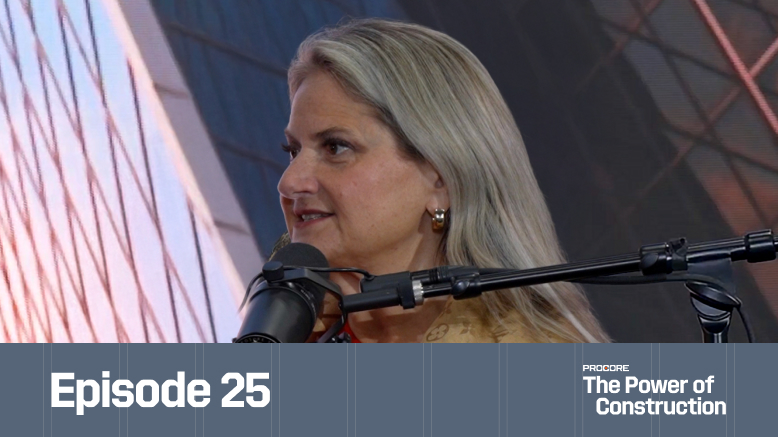— 10 min read
Cost Control in Construction: 7 Strategies to Help Reduce Overruns


Last Updated Mar 13, 2025

Jeffrey Brooks
Solutions Engineer, General Contractors
Jeffrey Brooks has built a robust career in the construction and engineering industry, showcasing over a decade of hands-on experience as a Project Manager, Estimator and Project Engineer. Jeffrey holds a Bachelor of Science degree in Construction Management from Colorado State University, where he graduated in 2011. He is currently a Solutions Engineer at Procore Technologies, where he assists enterprise and major general contractors by leveraging innovative solutions.

Kacie Goff
Contributing Writer
91 articles
Kacie Goff is a construction writer who grew up in a construction family — her dad owned a concrete company. Over the last decade, she’s blended that experience with her writing expertise to create content for the Construction Progress Coalition, Newsweek, CNET, and others. She founded and runs her own agency, Jot Content, from her home in Ventura, California.
Last Updated Mar 13, 2025

Controlling costs is a major concern In nearly every industry, but can be particularly pressing in construction. Due to the average net profit margin for construction businesses ranging from 3–7%, cost overruns can become a problem fast. That’s why many general contracting firms and subcontracting companies task specific people with cost control in construction management.
For the people responsible for planning for and monitoring costs on a project, that creates a lot of work. Cost management is no small feat. In this article, we’ll look into what goes into construction cost control, including key strategies to make it a little bit easier.
Table of contents
Understanding Cost Control in Construction Management
In short, cost control is the management of project-related costs against the project budget. That means planning, strategizing and accounting for costs to date and future costs, making sure that the total project cost will be less than the project budget. Ideally, project and financial managers want to see those numbers far enough apart to protect the company’s profit margin.
Cost control in construction usually gets fairly granular. It goes well beyond job costing (assigning costs to the specific project). Rather than simply lumping all costs in that project’s budget and hoping they don’t go over, project and financial managers often take a proactive approach.
Many stakeholders break down the individual project’s costs line by line, even going so far as to attach specific codes to different cost categories (i.e., establishing a cost breakdown structure). They analyze money spent and upcoming expenses to see where they’re over or under projections in each line of the budget.
The goal is to complete the project at or below budget, leaving as much money as possible to pocket as profit. Since that’s much easier said than done, companies benefit from deploying certain strategies. Here are some suggestions to boost cost control in construction.
7 Strategies for Cost Control in Construction
1. Create a monthly forecast.
As soon as the project is stood up and the project manager has a plan for the project’s budget, they should be projecting that plan.
Specifically, project managers should be doing a line-by-line forecast of the project’s budget on a monthly basis. They should be anticipating future costs and managing the budget proactively so that there are no — or at least fewer — surprises.
A strong monthly forecast looks forward to known upcoming costs (e.g., labor, materials, equipment rentals) while also reporting on all costs that have already been incurred. For instance, if a contract states that a subcontractor will bill at an hourly rate of $110, but the GC receives an invoice for $115, a monthly check-in can help project managers catch it in advance.
Once the forecast for that month has been created, the project manager should schedule a meeting with stakeholders.
The project’s superintendent is a particularly important person to get in the room because they’re the decision-maker about a lot of costs in the field. It may make sense to loop in people outside the company — like the project owner or a specialty contractor — at certain points in the project. The people around the table at the monthly forecast meeting may change, but the meeting should still happen on a set cadence.
At each monthly forecast meeting, the project manager should showcase the current state of the project’s costs and what has been projected. They then need to ask the team members gathered if they expect that the forecast will hold.
This monthly forecast meeting gives the person or team tasked with cost control the opportunity to learn about what’s really happening on the job. They might discover major hurdles like supply chain issues for a key material. Or they might learn about seemingly smaller issues like being over budget on temporary toilets due to a need for more frequent servicing. In any case, any incurred or anticipated costs associated with the project must captured and accounted for.
2. Conduct detailed planning and budgeting during preconstruction.
Cost control should start well before the project breaks ground. When an estimate for the project gets developed, the estimating team ideally involves the operations team. The goal is to align everyone on the plan for the project. Those estimators are tasked with building the budget to cover the project’s costs, and they try to get as close as possible to what the reality on the ground will be once crews hit the jobsite.
This is the project or financial manager’s opportunity to speak up. When they have a plan for how they will run that project, preconstruction is the time to share it. If they don’t advocate for their plan now, the estimators’ budget might not align with it. And since the project manager will get stuck with that budget either way, it’s important to communicate before those numbers get finalized.
The project manager might know, for example, that the project will require an engineer for the first few months to get through submittals and permitting. They may also recommend that the project could taper off that budget through the build’s middle phases, then bring that project engineer back in a bigger way in the later stages to help with the punch list.
In other words, the project manager should share their plan for the project along with what has worked well on past similar projects. This provides the estimating team with insight they can use to create a budget that’s as accurate as possible.
In the preconstruction planning phase, it’s also important to look at how the contract for the project is structured. Some owners don’t allow any corporate staff to charge time to the project, for example. If the company plans to use someone on the project who could be considered corporate staff (like a construction manager), they need to figure out how to work that into the project fee so that person’s labor doesn’t eat into profit.
Build a Strong Foundation with our Preconstruction Course
With 20+ years of experience, Ben Ashburn teaches you how to streamline planning, bidding, and procurement for better outcomes.

3. Pay attention to labor management.
In some ways, direct costs might seem like the easiest types of construction expenses to track. And, sure, keeping tabs on what’s been spent on materials should be fairly straightforward. But another direct cost — labor — needs special attention.
Labor is one of the riskiest parts of a project and an area in which cost control can go awry quickly. That’s particularly true because the buckets of dollars allocated to labor are typically large.
Let’s say the GC firm receives an architect's supplemental instruction (ASI) for a bunch of added scope. The firm then needs to decide if they will add additional project manager time to manage that and, if so, where the money to cover that labor will come from.
Carefully tracking the labor allocated to a project is a critical part of cost control in construction, and something all companies need to do to protect their profit margins.
4. Manage subcontractors effectively.
This tip for cost control in construction management applies specifically to people working for a general contractor. The way you buy out the job plays a big role in the project’s profitability.
Four specific actions can help here:
Reach out to a variety of specialty contractors
The more bids the GC receives, the more likely they are to get the work required at the best value.
Level bids.
Bid leveling ensures that the GC team is comparing apples to apples. As the firm explores their specialty contractor options, they should balance the lowest dollar offer against that sub’s experience with similar projects and their reputation in the area.
Buy out the job quickly.
While the first two steps are important, they should be executed as fast as possible. A faster job buyout means locking in prices early, which allows for better cost control planning.
Establish fixed pricing
Many GC firms choose to use fixed-price contracts whenever possible to avoid a creep in costs if that’s a material or labor escalation.
5. Track change orders (and their related costs) closely.
It’s important that all parties on the project — the owner, the general contractor and specialty contractors — have visibility into change orders. Ideally, subcontractors send the GC their open change order log as it updates. This way, the GC’s project manager can discuss open change orders on a regular (e.g., weekly) basis with both the specialty contractors and the owner.
Before change orders get accepted, they need to go through a rigorous approval process first. No change order should get the green light until the appropriate parties are confident the change is truly necessary.
Then, the project manager should pursue a 1:1 exchange for any change order costs. If a specialty contractor submits a necessary change order to the GC, for example, the GC’s project manager should pursue the required dollar amount with the owner. But if that specialty contractor had to submit the change order because another subcontractor made a mistake on the job, the GC’s project manager should try to recoup the cost from the sub that made the mistake.
The odds of getting the appropriate party to pay for the change order — preventing it from busting the budget — go up if everyone is on the same page. Open lines of communication and clear documentation make for fewer surprises and, as a result, a higher likelihood of the appropriate party taking financial responsibility without a disagreement.
6. Implement new technology.
Tracking costs on a project can be both difficult and time-intensive. Fortunately, technology can make it easier, particularly when it comes to monitoring costs for time and materials. The right solution(s) can enable the project manager to see what’s happening on the jobsite in near real-time and to centralize all incurred costs in their tracking system.
Tech tools can also leverage historical data to make projecting upcoming costs easier and more accurate.
7. Conduct yearly audits.
Cost control in construction is an ongoing task before and during a project. But it shouldn't necessarily stop once that project gets handed over to the owner.
It can be helpful to have project managers sit down once a year to audit cost reporting on completed jobs. This way, they can pinpoint where they may need to adjust the strategies they use for cost control in construction management. If they see, for example, that door installation went over budget on several projects, they can adapt accordingly. That might mean finding a new door installer or adapting future project estimates to include the higher cost.
At the yearly audit, they can benefit from pulling out each monthly forecast from the project. This should enable them to see how actual costs lined up against the budget at various project phases. This way, they can identify and analyze any trends in the efficacy (or lack thereof) of their cost control measures.
Stay updated on what’s happening in construction.
Subscribe to Blueprint, Procore’s free construction newsletter, to get content from industry experts delivered straight to your inbox.

Consistency in Controlling Costs
Cost control in construction management is an ongoing process that requires tweaking from project to project. On top of that, every project manager has their own knowledge base, skillset and preferences. Consequently, they all do things a little bit differently. What needs to stay consistent is having a plan and executing that plan. With a well-structured budget and a monthly forecast to monitor how the project is performing against that number, teams get a proactive way to monitor and control costs.
Was this article helpful?
Thank you for your submission.
75%
25%
You voted that this article was . Was this a mistake? If so, change your vote
Scroll less, learn more about construction.
Subscribe to The Blueprint, Procore’s construction newsletter, to get content from industry experts delivered straight to your inbox.
By clicking this button, you agree to our Privacy Notice and Terms of Service.
Thank you!
You’re signed up to receive The Blueprint newsletter from Procore. You can unsubscribe at any time.
Categories:
Written by

Jeffrey Brooks
Solutions Engineer, General Contractors | Procore
Jeffrey Brooks has built a robust career in the construction and engineering industry, showcasing over a decade of hands-on experience as a Project Manager, Estimator and Project Engineer. Jeffrey holds a Bachelor of Science degree in Construction Management from Colorado State University, where he graduated in 2011. He is currently a Solutions Engineer at Procore Technologies, where he assists enterprise and major general contractors by leveraging innovative solutions.
View profile
Kacie Goff
Contributing Writer | Procore Technologies
91 articles
Kacie Goff is a construction writer who grew up in a construction family — her dad owned a concrete company. Over the last decade, she’s blended that experience with her writing expertise to create content for the Construction Progress Coalition, Newsweek, CNET, and others. She founded and runs her own agency, Jot Content, from her home in Ventura, California.
View profileExplore more helpful resources

Profit from Predictability: Construction Software as a Business Strategy
For general contractors, managing complex, multi-million-dollar projects, every project phase — from planning and budgeting to on-site execution — is an opportunity to lose time and money. Construction software is...

Defending Against Financial & Legal Risks on Megaprojects
The construction industry has seen marked growth in megaprojects. Some experts classify any project over $500 million as a megaproject, while others argue that the build needs to be $1...

Unlocking Project Intelligence: Moving from Raw Data to Actionable Insights
The construction industry faces a wide range of challenges, from ongoing labor shortages to frequent cost overruns. But some the biggest hurdles all stem from unpredictability. The general contractors (GCs)...

Who is accountable for innovation in construction?
Everyone says construction needs to innovate—but no one agrees on who’s actually responsible for making it happen. Is it the owner? The builders? The tech vendor? Or is innovation everyone’s...
Free Tools
Calculators
Use our calculators to estimate the cost of construction materials for your next project.
Templates
Find a template to help you with your construction project tasks.
Material Price Tracker
Get the latest U.S. retail prices and view historical trends for common building materials.
Glossary
Explore key terms and phrases used in the industry.
